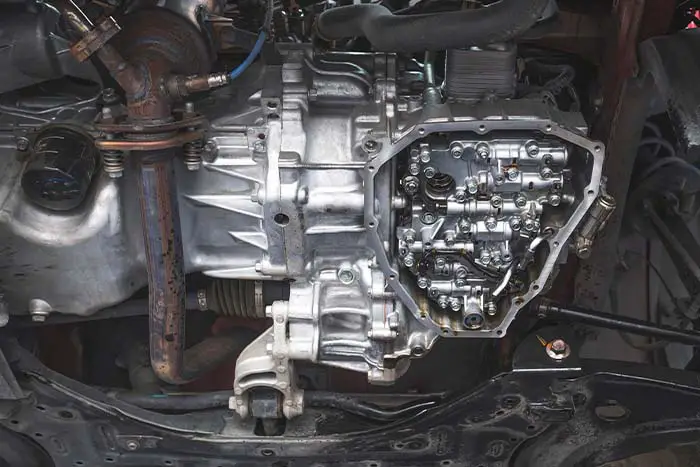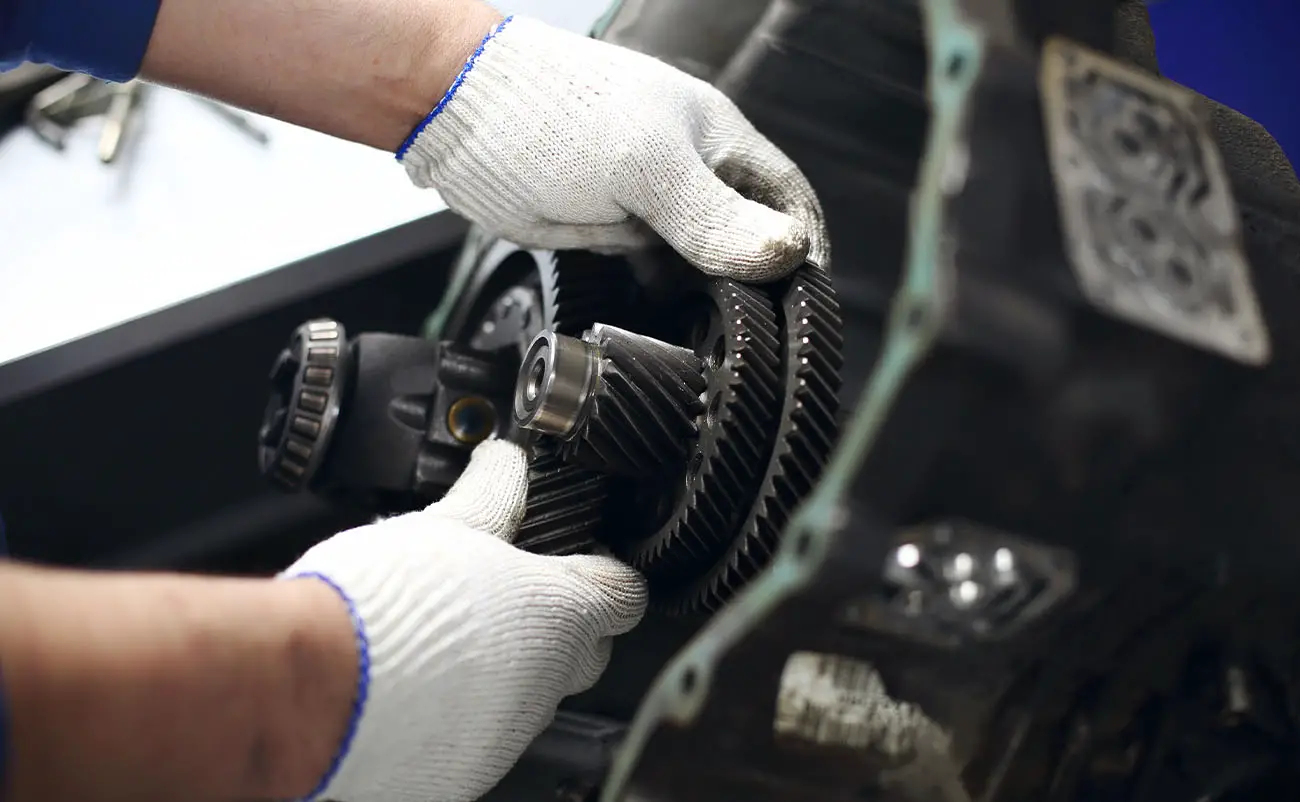The automatic transmissions in today’s cars are incredibly complex. They contain clutches, gears, bands, fluid, and other parts that all work together to make your car move. The transmission transfers the energy from the engine to the wheels, making your car drive. Without a properly working transmission, your vehicle will not get you where you need to go.
Unfortunately, most people are unable to perform their own transmission repairs. Transmissions can be challenging to diagnose, difficult to access, and difficult to repair. However, knowing the basics of what type of repair might be needed can prevent an auto repair shop from taking advantage of you. If your transmission is giving you trouble, then keep reading. We will tell you how to know when your transmission needs a repair as well as what it will likely take to fix it.
Table of Contents
Automatic Transmission Basics & Overview
As we already mentioned, the automatic transmissions in modern vehicles are quite complicated. They contain a set of clutches, bands, and gears that all work together to properly shift as you drive. Your automatic transmission fluid also plays an important role in shifting gears, and your torque converter is a critical component also. The torque converter helps the transmission decide which gear is needed based on the current engine speed. In addition, the transmission fluid pressure determines how quickly or firmly the transmission needs to shift gears.
In addition to the mechanical components in the transmission, your car’s computer also plays a significant role in the function of your transmission. Your vehicle’s electronic control and transmission control modules constantly monitor the vehicle’s speed, throttle position, engine RPM, and other data points. The computer uses this data to inform the transmission when it needs to shift and how quickly it should shift. Although this is a basic overview, you can definitely see how complex an automatic transmission is.
A manual transmission is not as complex as an automatic. Although it still contains gears, the driver must shift the transmission manually. The driver must depress the clutch pedal to disengage the transmission. The driver can shift into the next gear and reengage the clutch at that time. While manual transmissions can also fail, they are far less likely to experience problems.
Signs Your Transmission Needs Repair

So, how can you tell when you need an automatic transmission repair? Some signs are obvious, while others are not as glaring. Here are some of the most common things to watch and listen for. If you experience any of these symptoms, you should get your vehicle to a repair shop for transmission service right away. Ignoring transmission problems will only lead to a more significant repair in the end!
— Leaking Automatic Transmission Fluid
Leaking transmission fluid can be a big problem! The transmission fluid in your vehicle performs many valuable functions. First, it lubricates and cools the internal components of your transmission. A low fluid level can lead to overheating, and heat is one of the worst enemies of an automatic transmission. Transmission fluid also helps to control and modulate the gear shifts within the transmission. Low fluid levels can cause shifts to be too slow — almost hanging between gears. Low fluid could prevent your transmission from shifting altogether if the fluid is low enough. Keep an eye out for reddish or pink drops underneath your vehicle. Any signs of a transmission fluid leak should be addressed right away.
— Whining Or Grinding Sound
You should never hear any strange noises coming from your transmission. Although you can probably hear your car’s engine when you accelerate quickly, you should not hear loud noises coming from your transmission. If you notice a whining or grinding sound, especially around the time your vehicle shifts gears, this is definitely a sign of a problem. Your transmission fluid pump could be starving for fluid due to a clogged transmission filter or low fluid level. Similarly, worn bands or broken gears could cause a grinding noise as you drive. If you hear any of these sounds while driving your vehicle, get your car to a transmission repair shop quickly. In severe cases, your check engine light might also illuminate.
Whining sounds can also result from low differential fluid, and your axles might not be adequately lubricated. However, if the sound changes pitch or volume around the time the transmission shifts gears, you know for sure that you have a transmission issue.
— Improper Shifting Or Slipping
Your car’s transmission should shift smoothly but firmly as you drive. Shifts that do not seem normal are probably a sign of a problem. You might notice that your transmission seems to hang between gears, or it might slam into gear too harshly. Either of these conditions is a problem. Similarly, a slipping transmission is a definite problem. If your transmission is slipping, it could be caused by several different things. However, none of them are good. You will want to visit an automotive repair shop as soon as possible to have them diagnose the problem.
— Won’t Go Into Gear
If your vehicle doesn’t go into gear, you probably already experienced a transmission failure. In some cases, you might find that the car won’t go into reverse. Unfortunately, you will need to pay for towing to your dealership in that case. Driving a car that won’t go into gear properly can be extremely dangerous, so you should have your car towed to the repair shop. The shop can perform some diagnostic tests to determine the cause of the issue. More than likely, you should get ready for some expensive auto repair services.
— Burning Smell
Strange smells from your vehicle can also be related to transmission issues. If your transmission begins to overheat, the hot fluid can smell like burning rubber. Similarly, the clutches inside your transmission can smell like burning rubber as they slip. You might experience this smell even if you have a manual transmission. If you notice a burning smell coming from your car, you should have an auto mechanic inspect your car immediately. Continuing to drive could pose a safety hazard to you and others on the road.
Repairing A Faulty Transmission
So, what does it take to repair a transmission that is having problems? The answer depends on the specific cause of the problem. If you are lucky, a transmission fluid change or fluid flush might fix the problem. However, this is usually only the case when you are experiencing fluid-related issues. Perhaps the fluid is dirty or burned. New transmission fluid might solve the problem.
If you notice a fluid leak, you could have a problem as simple as a faulty transmission pan gasket. This is an easy fix for a qualified mechanic. However, many transmission problems are mechanical. This means that the faulty internal parts must be replaced.
If your transmission has trouble shifting, you might only have a faulty shift solenoid. This part is fairly easy to replace, especially for an ASE mechanic who has experience with transmission repairs. If you hear whining or clunking sounds, the repair is likely to be more complex. You might need a transmission rebuild or even a transmission replacement in that case. Either of these requires an experienced mechanic with years of experience, and the repair cost will be high as well. You do not want to use a mechanic who is attempting a transmission repair for the first time!
Thankfully, most rebuilt transmissions include a warranty. The shop that performs the repair will typically give you a warranty on the repair. If you experience any problems with the transmission within the warranty period, you can return to the shop and have the issue repaired at no cost.
Manual transmission repairs are generally not as complex as automatic transmission repairs. One reason for this is that manual transmissions do not have as many moving pieces inside. Likewise, manual transmission repair costs are generally lower than the bill to fix an automatic transmission.
Importance Of Performing Regular Transmission Service

Thankfully, there are some things you can do to help prevent transmission problems. These maintenance services are a critical part of car care that many people often overlook. The most important service that you can perform is a regular fluid exchange. A transmission fluid flush will remove the old fluid from your transmission and replace it with fresh new fluid.
Transmission fluid becomes dirty over time, and it also loses its ability to cool and lubricate the internal transmission components. For this reason, it is critical to regularly replace the fluid. While a transmission fluid change does not need to be performed as regularly as an oil change, most mechanics recommend a fluid change every 40,000 to 50,000 miles. You should refer to your owner’s manual for your manufacturer’s recommended interval.
If your transmission has a filter that can be replaced, you should also replace the filter when you change the fluid. Filters can become clogged, and they can prevent your transmission fluid pump from circulating the proper amount of fluid through the system. Spending a little money on these preventive services might help you avoid a large bill for transmission repair services down the road.
Average Cost Of Transmission Repair Services
You are likely wondering how much it is going to cost to repair your transmission. The cost to repair your transmission varies widely based on the specific repair that is needed. If you simply need to perform a transmission fluid flush, the repair is likely to cost around $150 to $250. Similarly, repairing a leak due to a faulty pan gasket or seal will typically cost in the $200 to $400 range.
Replacing a shift solenoid will typically incur a repair bill of around $250 to $500. Rebuilding a transmission requires much more time and expertise. The average cost to rebuild a transmission can range from $2,000 to $4,000, depending on the make and model of your vehicle. Transmission replacement can range anywhere from $4,000 to $8,000. You can sometimes save a little money by replacing your transmission with a refurbished unit, although you can still expect to pay $3,000 to $7,000 in that case.
The Bottom Line
Transmission repairs are not fun, although they are sometimes a must. If you notice your transmission leaking fluid, shifting improperly, or making a whining or grinding noise, you should have a mechanic check it out right away. You might get lucky and only need a fluid change or new shift solenoid. However, a transmission rebuild or replacement will sometimes be necessary. Expect the job to take several days and cost you a few thousand dollars in that case.
Frequently Asked Questions
Is it worth it to fix a transmission?
Whether or not a transmission is repairable often depends on the extent of the internal damage. If most of the internal parts are not damaged, then you can often repair the transmission. In that case, the repair job will usually be cheaper than a total rebuild or replacement. However, if your transmission has experienced catastrophic failure, it is not worth it to repair the transmission. You should simply replace it with a new or refurbished transmission in that case.
What is the average lifespan of a transmission?
Most transmissions last well over 100,000 miles, especially if proper maintenance has been performed. In some cases, your transmission might last you over 200,000 miles. The lifespan of your transmission is often related to how well you have performed maintenance on your vehicle. If you never change the transmission fluid and drive in hot temperatures, the transmission is likely to fail much sooner. However, if you have performed regular fluid and filter changes, you might find that your transmission lasts over 200,000 miles.
How do you know if it’s time to replace the transmission?
If you notice any of the symptoms described in this article, like improper shifting, leaking fluid, or whining noises, you should have a mechanic inspect the transmission. Typically, there are signs that a mechanic can look for that signal the need for a complete replacement. The mechanic might notice a lot of metal shavings and debris in the transmission fluid. This often signals the failure of many internal components, and it is generally best to replace the transmission in that case.

